What are the two things Australians love the most? It’s real estate and smartphones!
Imagine this; you’re on a bus on your way to work while you browse on your phone, and every now and then, you glance up and check out a beautiful property and wonder how much it’s worth.

What if we told you there was a way to satiate both your loves, that of real estate and smartphones, all in one place? As such, real estate apps for Android and iOS are your new best friends. Of course, it’s true that there are a million apps out there that are not necessarily up to part.
And so, we have compiled a list of some of the best real estate applications in Australia for you.
What apps do Australians use to find real estate?
We have compiled a list of the most popular and loved property apps for available smartphones (Android and iOS devices). Let’s dive into some of the best real estate apps in Australia.
1.Realestate.com.au
This happens to be the most downloaded real estate mobile app in Australia. The app has coined itself the “Number 1 Place for Property”. Both the website and the application are created by the international real estate advertising company REA Group, majority-owned by News Corp Australia.
After Realestate.com.au established itself successfully as the best real estate website in Australia, it decided to expand into the mobile app market in December 2010. It generated more than one million downloads in under two years.
Advantages:
One of the key advantages of Realestate.com.au is the depth of property information it provides. Users can find everything they need to know about a potential property, including price history, estimated value, nearby schools, and even the type of neighbors they might expect. The interactive maps and street views further enhance the browsing experience by giving users the ability to virtually explore an area before committing to a physical visit. Additionally, the app offers integration with financing options, such as home loan calculators and a partnership with different mortgage lenders to provide users with accurate financial estimates.
The app’s ability to send personalized notifications is another plus. Users can set specific search parameters (e.g., suburb, price, number of bedrooms), and the app will notify them when a property that fits their criteria is listed. This makes the search process much more convenient and time-efficient, as users do not need to constantly scroll through new listings. On the downside, because it is so widely used, competition for properties listed on Realestate.com.au can be intense. In major metropolitan areas, properties are often snapped up within hours of being posted.
Paid functions:
Realestate.com.au also offers a premium subscription known as Premier Property, which allows sellers to increase the visibility of their listings. The pricing for this feature depends on the area and competitiveness of the market but can range from AUD 1,000 to AUD 3,000. Premier Property listings are displayed prominently on the app, giving sellers a distinct advantage in attracting potential buyers. For those who are serious about selling their property quickly, this paid functionality can be worthwhile, but it is considerably more expensive than a standard listing.

By June of 2018, that number had grown over 7.8 million! It has user ratings of 3.8 on Google Play and 4.7 on the App Store. It can be used to search for apartments, houses, rooms, or land to buy and rent in Australia.
2. Domain
This app has more than 6.5 million downloads and is a close second to realestate.com.au.
As there is a rivalry between the creator of Domain, Fairfax Media, and the creator of realestate.com.au; REA Group News Corp Australia, Domain has had to fight hard for the title of the top real estate app in Australia.
This battle even escalated to the point of reaching court when REA Group had objections regarding a Domain ad in 2017 which proclaimed it to be the Number 1 Property App in Australia. As such, it now advertises itself as Australia’s highest-rated real estate app.
Advantages:
One advantage of Domain is its focus on user experience. The app provides personalized features like a “My Inspections” section, where users can organize inspection times for different properties, making it easier to stay on top of multiple viewings. The Domain app also offers a feature called Domain Property Profiles, which provides in-depth insights into individual properties, including market trends, price estimates, and sales history. The Domain Inspect feature also gives users the ability to book inspection slots right from the app, streamlining the property hunting process.
Disadvantages:
The app’s biggest disadvantage might be the lack of breadth in some rural areas compared to Realestate.com.au. While Domain is robust in urban and suburban regions, its rural coverage can occasionally fall short, leaving buyers outside major cities with fewer options. However, in many areas, Domain compensates with strong tools for evaluating the neighborhood—including features like the school catchment calculator that lets families determine the likely local school for a given property.
Paid functions:
Domain also provides a Domain Platinum service that caters to property sellers. It costs between AUD 500 and AUD 2,000, depending on the locality and demand in that area. This service ensures that the property is highly visible to potential buyers by giving it a preferred position in search results and better promotion on the app. For buyers, there is an optional Property Alerts subscription costing around AUD 10 per month, which provides users with exclusive access to upcoming listings before they appear publicly.
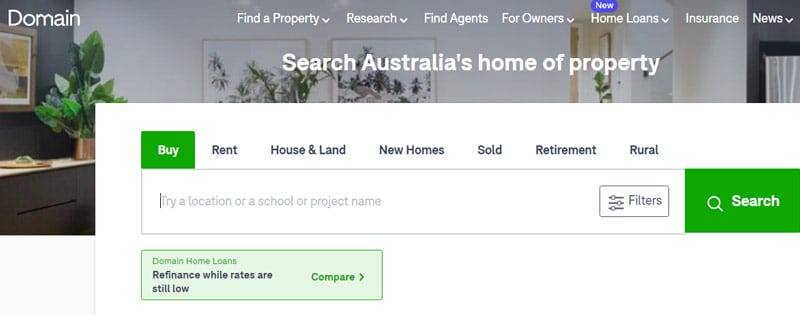
In 2016, it was awarded for its design and functionality, labeled as Google Play’s best apps of the year, and even advertised on Google Play as an “Editor’s Choice” app. It has a rating of 4.3 on Google Play and 4.6 on the Play Store.
3. Soho
The Soho App has been labeled as “Tinder for Property” and was founded by ex-Airtasker Co-Founder Jonathan Lui in 2017.
With the help of this app, users can find properties to buy using the swipe gesture that is rather similar to the online dating app called Tinder. It’s quite humorous, really!
Advantages:
The most significant advantage of Soho is its swipe feature, which adds an element of fun and simplicity to property searching. Users can set their preferences, and the app will show them listings that match. They can then swipe left to skip or swipe right to save a property, creating an engaging, easy-to-navigate search experience. This design is particularly helpful for those who want to browse casually rather than wade through long lists of properties. Furthermore, Soho offers a feed that is continuously updated based on the properties users have interacted with, which makes the process feel more personalized.
Disadvantages:
However, a disadvantage of Soho is that its innovative approach might not appeal to everyone, particularly older users or those who are not comfortable with app-based navigation. Some might find the interface oversimplified compared to the detailed search options available on Realestate.com.au or Domain. Additionally, the app’s inventory might not be as comprehensive, especially in rural or less popular areas, making it necessary to use additional platforms for a thorough search.
Paid functions:
Soho offers a Soho Premium membership, which allows property owners and agents to gain increased exposure. This premium membership costs around AUD 15 per month and gives sellers the ability to boost their listings to ensure they are seen by a larger audience. The membership also provides additional analytics, including data on how often listings are viewed and interacted with, which can be useful for evaluating interest levels.
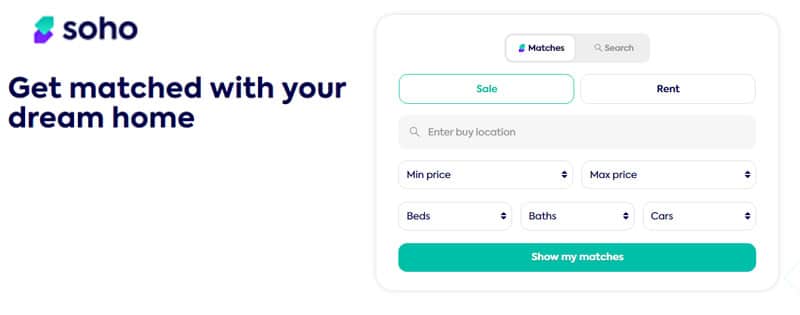
Users also get access to social news feeds and groups containing real estate agents and brokers that regularly share property insights to help buyers with their knowledge. This app has had over 30k downloads since 2017 and is used in Australia and Singapore. It has a rating of 3.6 on Google Play and 4.5 on the App Store.
4. Homely
Are you looking for some of the best rental apps in Australia? Homely is a widely used app for buying and renting across Australia.
Users can customize their searches based on their preferences, such as price, bedrooms, bathrooms, pools, and other property features that they may require.
Advantages:
A significant advantage of Homely is the depth of local information available. Users can explore detailed reviews from residents and prospective buyers, which is a huge help when considering a move to an unfamiliar suburb. The street reviews, in particular, are a standout feature. Unlike other apps that only focus on properties, Homely helps users understand the culture and vibe of specific streets and neighborhoods, offering insights into the daily living environment. Furthermore, Homely’s interface is clean and intuitive, making it easy to navigate through different features without feeling overwhelmed by data.
Disadvantages:
On the downside, the listings on Homely are not as extensive as those on Realestate.com.au or Domain. Since the app focuses more on providing a “homely” feel through community insights, it lacks the massive number of listings that its competitors provide. Thus, users may find that they need to use Homely in conjunction with other property search apps to get a complete picture of the market.
Paid functions:
Homely offers a Premier Agent service for real estate agents that provides more visibility and exclusive leads. The pricing for this service is subscription-based and starts from around AUD 300 per month. This service allows agents to appear prominently in search results and makes them the preferred contact for buyers interested in specific suburbs. For sellers, Homely provides featured listings, which can cost anywhere between AUD 500 and AUD 1,500, allowing them to make their property more visible to potential buyers.
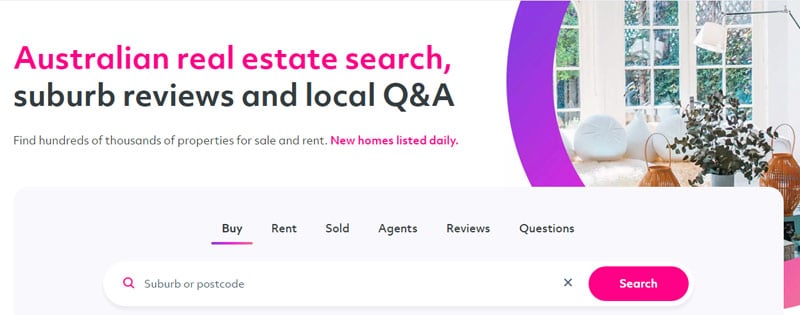
It also offers the added functionality of inspection and auction reminders on users’ calendars and offers a sold hub where users can see the most recent properties sold through either auctions or private sales. Homely is rated 4.6 on Google Play and 4.6 on the App Store.
5. OnTheHouse
With the help of OnTheHouse, users get access to important information such as land value and property profiles, including the number of bedrooms, bathrooms, car parks, and land size.
Users can search by address, suburbs, or even postal codes to find property values, sale histories and compare properties for sale or ones that have already been sold.
Advantages:
One of the main advantages of OnTheHouse is its extensive property data, providing detailed insights on a large portion of properties in Australia. It also offers market research tools, which are invaluable for understanding trends and neighborhood dynamics. OnTheHouse displays current listings for sale and rent, alongside information on off-market properties, giving users a comprehensive view of the real estate market.
Disadvantages:
However, some users have reported inaccuracies in property value estimates and sales data, which can affect the reliability of the information presented. Furthermore, the platform’s user interface might not be as modern or user-friendly as other apps, potentially impacting overall user experience.
Paid functions:
OnTheHouse offers a free platform for users to access property data and listings. For real estate agents and agencies, there are options to enhance their profiles and listings through the Agent Centre, an admin portal that helps manage brand presence on the platform. This includes updating agent and agency profiles, managing branding assets, and ensuring listings are displayed properly. Although specific pricing for these services is not detailed, they provide agents with increased exposure and lead generation opportunities.
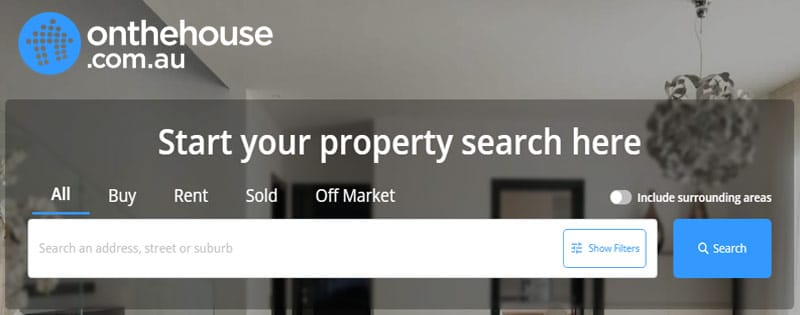
It is important to know that this app has a history of crashing, as Android users have recently complained. Property Value Search is rated 1.8 on Google Play and 3.7 on the App Store.
6. View.com.au
On this app, users can browse for properties they wish to buy and rent, search for existing sold properties, find out the current valuation of homes, and get access to an agent within Australia.
Users will no longer have to search separately for “apps for real estate agents Australia” or “estate agent apps“ as this app does everything for them. Property searches can be filtered by property types, bedroom numbers, bathroom numbers, and car parks.
Advantages:
One of the platform’s standout features is its advanced map-based search, powered by high-resolution aerial imagery from NearMap. This allows users to explore properties with detailed visual context, including heritage overlays and zoning information, even for properties not currently on the market. The inclusion of unlisted properties provides users with a broader view of the market, enabling them to express interest in homes that are not officially listed for sale.
Disadvantages:
However, some users have reported issues with the app’s performance, including bugs and crashes, which can hinder the overall experience. Additionally, while the platform provides extensive property data, the accuracy of certain information, such as price estimates, may vary and should be cross-referenced with other sources.
Paid functions:
View.com.au operates on a ‘freemium’ model, allowing vendors to list their properties for free, with optional paid upgrades available for enhanced visibility and promotion. The pricing for these premium features varies based on the level of exposure desired and the specific services selected.

Users can even create a shortlist of properties they love and want to choose between. Realestateview.com.au is rated 3.2 on Google Play and 4.8 on the Play Store.
7. BMT PropCalc
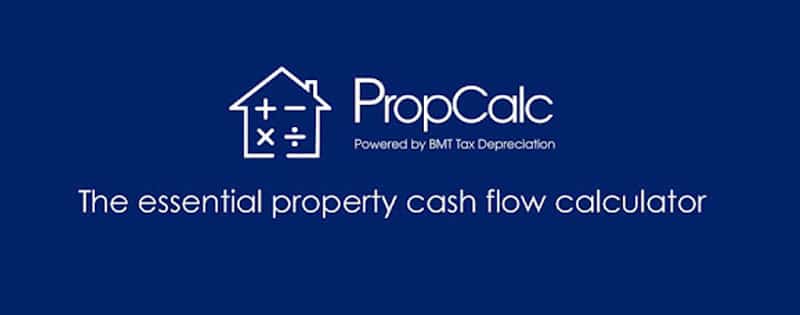
BMT PropCalc is a property cash flow calculator developed by BMT Tax Depreciation, designed to assist users in assessing the financial implications of owning a property. Available as an app for iOS and Android devices, PropCalc goes beyond traditional mortgage calculators by accounting for a comprehensive range of expenses and potential income sources. It allows users to get a detailed understanding of the cash flow of their investment properties. PropCalc considers expenses such as interest, stamp duty, insurance, council rates, property management fees, body corporate fees, and maintenance costs, which helps users understand the complete financial picture. Additionally, it takes into account potential rental income, occupancy rates, and depreciation claims available from income-producing properties, which gives users a realistic view of the after-tax cash flow.
Advantages:
PropCalc’s user-friendly interface is another strength, making it accessible for both novice and experienced property investors. The app allows users to input customized data, and it generates detailed reports that help investors make informed decisions about property investments. However, PropCalc is tailored specifically for the Australian property market, which limits its applicability for those interested in international investments. Moreover, while the app is free to use, accessing features such as saving and comparing properties requires registration via MyBMT, which might be seen as an additional barrier for some users.
Paid functions:
PropCalc is available to download and use for free, but for the best experience, users are encouraged to register via MyBMT, which is a free online portal that helps manage depreciation and other investment property needs. Registration through MyBMT allows users to save and compare properties and access detailed financial reports. Beyond PropCalc, BMT Tax Depreciation also offers additional services, such as tax depreciation schedules, which are paid services designed to maximize depreciation deductions for property investors.
This app helps account for a range of interests, as per their description, such as interest, stamp duty, deposit amount, council and property management rates, insurance, body corporate fees, maintenance, and repair costs. This app is rated 4.5 on Google Play and 4.4 on the Play Store.
8. TenantApp
TenantApp is designed specifically for renters, making it a niche but essential tool for those looking to find rental properties in Australia. It simplifies the process of searching for rentals, booking inspections, and even applying for properties—all in one place. TenantApp integrates with several other rental platforms, such as PropertyMe and InspectRealEstate, creating a centralized experience for rental property management.
Advantages:
One of the key benefits of TenantApp is its focus on simplifying the rental process. Users can browse rental listings, book inspections, and even apply for properties directly through the app, eliminating much of the paperwork and manual steps usually involved in renting a home. Another advantage is that TenantApp allows tenants to manage multiple applications simultaneously, keeping track of the status of each application and any upcoming inspection appointments. The app also provides real-time notifications, so users never miss an opportunity to view a property or submit an application.
Disadvantages:
The downside of TenantApp is that it does not cater to buyers, making it less versatile than some of the other real estate apps. Additionally, while the app’s user interface is clean, its reliance on third-party integrations can sometimes lead to inconsistencies or missing information between platforms, which may confuse users who are unfamiliar with how rental applications are processed in Australia.
Paid functions:
TenantApp offers a premium feature called Tenant Verification, which costs approximately AUD 30 per application. This allows potential tenants to verify their identity and rental history in advance, making it easier to apply for multiple properties without repeating the verification process. This service can save renters time and help them stand out in competitive rental markets, as it shows landlords that they are serious candidates.
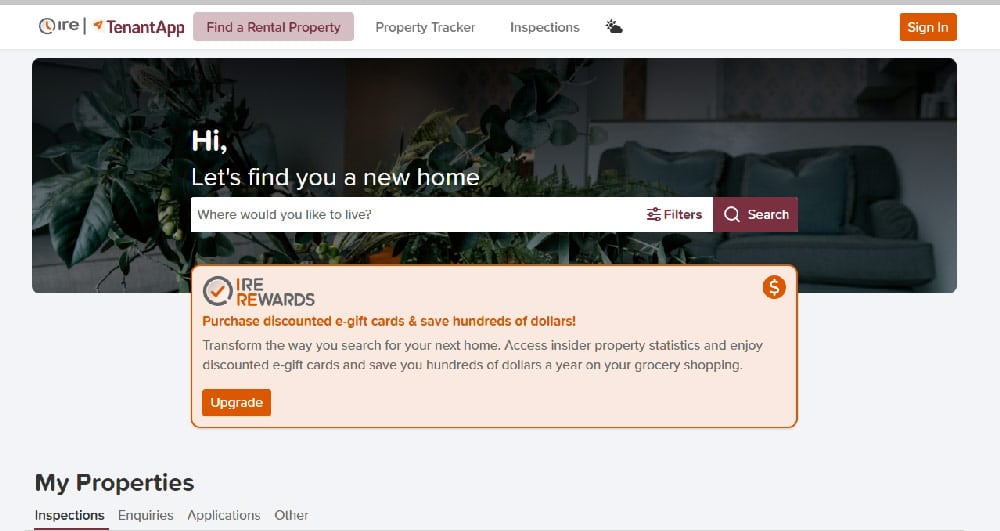
This app is rated 3.0 on Google Play and 4.6 on the Play Store.
9. Flatmates
Flatmates.com.au focuses on shared accommodation, making it a popular choice for those who are looking for roommates or trying to find a room to rent. Flatmates is ideal for students, young professionals, or anyone looking to save on rent by sharing a living space. The app allows users to create a profile, search for available rooms, and connect with potential flatmates, all through an easy-to-use interface.
Advantages:
One advantage of Flatmates is the community-oriented nature of the platform. Users are not just searching for rooms; they are also connecting with potential flatmates, which adds a social element to the search. Profiles are detailed, and the platform encourages users to share interests and preferences, which makes it easier to find a compatible living situation. The app also provides secure messaging, which helps users communicate without sharing personal contact information until they feel comfortable.
Disadvantages:
However, the app is limited to shared accommodations, which means it won’t be useful for those looking for an entire property to rent or buy. Another disadvantage is that some users have reported fake listings or scam attempts, which is a risk on any platform involving shared housing. Flatmates has implemented measures to combat these issues, but it still requires users to exercise caution.
Paid functions:
Flatmates offers a Flatmates Boost service for AUD 25 per week, which ensures that listings appear at the top of search results, making them more visible to potential flatmates. Users can also pay for Early Bird Access at around AUD 15 per month, allowing them to contact new listings 7 days before standard users, giving them a significant advantage in competitive areas.
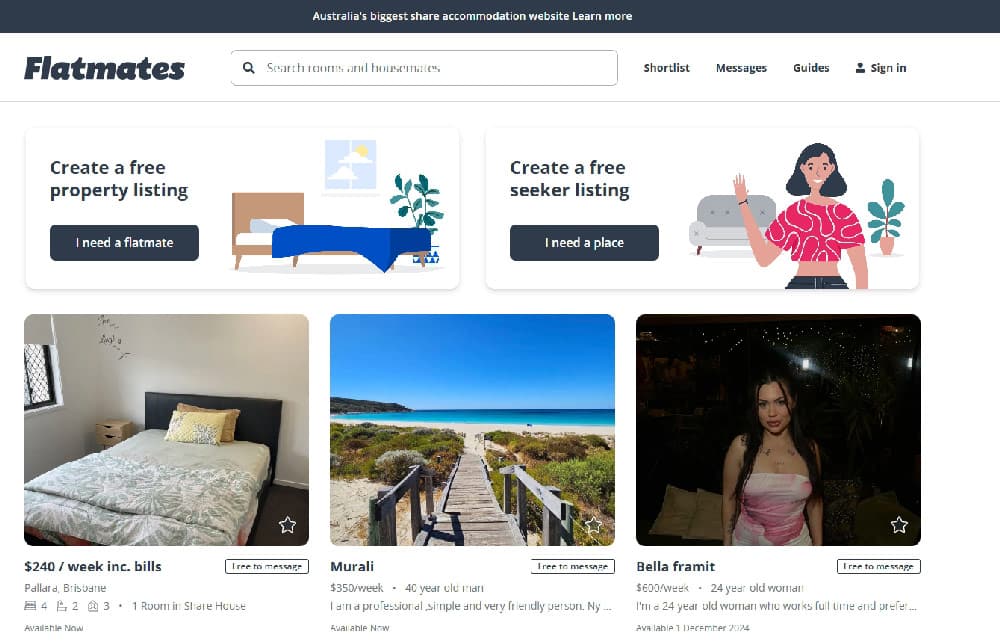
This app is rated 4.1 on Google Play and 4.6 on the Play Store.
10. Houzz
Houzz is primarily known as a home design and renovation platform, but it also offers real estate listings, making it a versatile tool for those looking to buy, remodel, or get inspired by design ideas. The app offers a comprehensive library of design photos, product recommendations, and even a marketplace to purchase home decor items directly. Houzz’s property listings feature properties for sale that highlight design and renovation potential.
Advantages:
Houzz’s primary advantage is its design library, which offers millions of high-quality photos of interior and exterior designs. For users who want to buy a fixer-upper or simply want inspiration for remodeling their current home, this feature is invaluable. Houzz also connects users with professionals—such as architects, designers, and contractors—making it easy to turn a vision into reality. The shopping feature is also a plus, as users can browse and buy furniture, lighting, and accessories directly from the app.
Disadvantages:
The main disadvantage of Houzz as a real estate app is that its property listings are not as extensive as those found on more specialized platforms like Domain or Realestate.com.au. Houzz caters primarily to design and renovation, so its real estate listings tend to be limited to properties with notable design features or renovation potential, which may not appeal to everyone in the market.
Paid functions:
Houzz offers a Houzz Pro subscription for professionals in the home design industry. This service costs approximately AUD 80 per month and provides tools for client management, project planning, and enhanced visibility on the platform. For users, Houzz also offers a Premium Shopping Membership for AUD 30 per year, which provides exclusive discounts on products and free shipping on many items.

This app is rated 4.7 on Google Play and 4.8 on the Play Store.



'10 Best Real Estate Apps in Australia' have no comments
Be the first to comment this post!